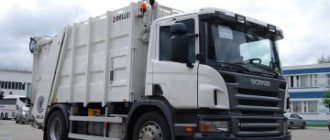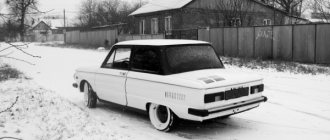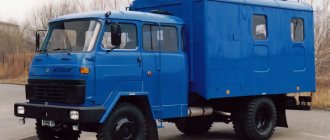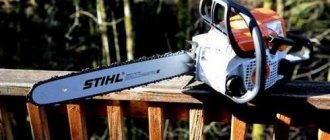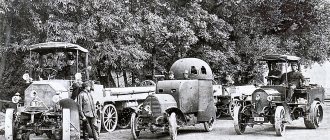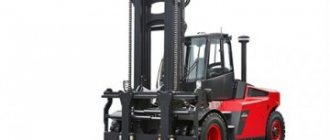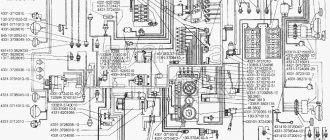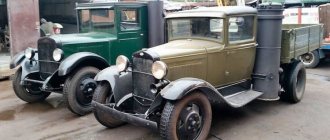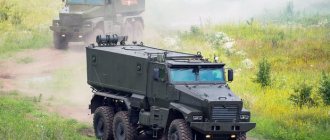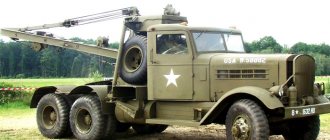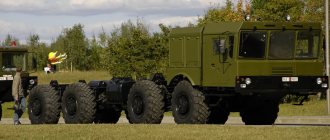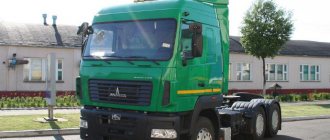Steyr-Daimler-Puch AG
| Former type | Aktiengesellschaft (Joint Stock Company) |
| Industry | Transport, Defense |
| Fate | Divide into departments; balance received |
| Based | 1864 |
| Non-existent | 2001 |
| Headquarters | Steyr, Upper Austria, Austria |
| Goods | Vehicles (cars, trucks, buses, motorcycles) Weapons |
Steyr-Daimler-Puch
(German pronunciation: [ˈƩtaɪɐ ˈdaɪmlɐ ˈpʊx]) was a large manufacturing conglomerate based in Steyr, Austria, which was split up in stages between 1987 and 2001. The components and operations continued to exist under different owners and new names.
Story
Share of Steyr-Werke AG, issued June 14, 1926
Company originally known as Josef and Franz Werndl and company
was founded in 1864 as a rifle manufacturer.
It grew rapidly during the First World War, by the end of which it employed 14,000 people. The company began producing bicycles in 1894 and Steyr automobiles after 1918. In September 1917, Steyr hired Hans Ledwink, now remembered as one of the greatest automobile engineers of the twentieth century but then relatively unknown, to the position of "Chefkonstrukteur", heading creating your own automobile business.[1] The first Steyr car, a six-cylinder Type II "12/40", appeared in 1920. It was heavy and well built, if a little bulky; However, sports versions soon appeared with an impressive list of international achievements. The small but luxurious 1.5-liter six Type XII of the late twenties received acclaim from the international automotive press. Steyr 200 Steyr-Puch logo on Pinzgauer Steyr-Puch logo on Puch 500
The company changed its name to Steyr-Werke AG
in 1926. In 1934, Steyr merged with Austro-Daimler-Puch to form the Steyr-Daimler-Puch company. The range produced during these years mainly consisted of very modern designs, partly or entirely sporty. body block design in a streamlined livery, from the liter Steyr 50 to the 2.3 liter Steyr 220 "six".
During World War II, when Austria was part of the Third Reich, Steyr-Daimler-Puch CEO Georg Meindl became one of the first German industrialists to propose using slave labor from concentration camps to increase the workforce in Steyr. The request was approved and the prisoners were transported by guarded train from the Mauthausen-Gusen camp complex to Gusen 30 km away. Later, on January 5, 1942, Meindl wrote a letter to the SS Gruppenführer. Ernst Kaltenbrunner recommend building a new "satellite" prison camp closer to the Steyr factory complex, explaining how this would reduce the time and casualties of prisoners traveling to and from work, as well as reducing security and transport overhead costs. This was approved and the prisoners were used to build facilities (air raid shelters, etc.) and also to replace labor in production. This practice had not previously been used by other large German companies, although others followed suit, including Mercedes Benz and MAN. A line of vehicles was intended for military use, including the Steyr RSO. Raupenschlepper Ost with an air-cooled 3.5 liter V8 engine designed by Ferdinand Porsche, who was working for the company at the time. During wartime, small arms, assault rifles, machine guns and aircraft engines were also produced here.
After the war, Steyr-Daimler-Puch built diesel engines for trucks and buses, small and heavy tractors, and resumed production of passenger cars. Steyr first assembled the FIAT 1100E and then put its engine into the Fiat 1400, renaming the car "Steyr 2000". From 1957 until the early 1970s it produced the tiny Puig 500 under license from FIAT, again with an Austrian-designed engine.
Most notable, however, was the SUV lineup, starting with the two-cylinder engine. Haflinger and 4 x 4 or 6 x 6 Pinzgauer, then the Fiat Panda 4x4 (999 cc) to the Mercedes-Pooh G. SDP was the original designer and manufacturer of these trucks. The Haflinger was produced from 1959–1974, the Pinzgauer from 1971–2000, and the Puch G (also known as the Mercedes G-Class) from 1979.
The Puig company division produced a series of motorcycles, mopeds, and motor scooters sold in the United States through Sears Roebuck including the Puig 250 SGS which was delivered in a cardboard box to the customer's home.[2] The Austro-Daimler subsidiary produced heavy tractors and trucks for the Imperial Austrian Army (until 1915). Production of Steyr's main agricultural tractors began in 1947.
After the war, Steyr-Daimler-Puch resumed production of bicycles and mopeds, gradually establishing distributors in several countries to manage their sales. Steyr also produced bicycles for sale to other retailers, most notably Sears. In the mid-1970s, Steyr-Daimler-Puch America was registered in Connecticut, which imported and distributed bicycles and mopeds. Puch Austro-Daimler bicycles continued to be produced in Graz in Austria until the company's motorcycle and bicycle operations were sold off in mid-1987. Piaggio & CSpA Italy.
Thanks to their extreme durability and strength, Steyr products have won many enthusiast friends around the world.
Steyr Puch Pinzgauer 1971–1986
In May 1971, the first two-axle all-terrain vehicles (Pinzgauer 710) had already entered service with the Swiss army, and a year later they were joined by trucks on a three-axle chassis (Pinzgauer 712). Erich's team didn't have to go to the trouble of designing a new base: the independent suspension and tubular chassis design made it possible to simply slap on a rear axle, and, if desired, continue the improvement by adding new axles, a propeller, and anything else that could rotate and transmit rotation. The characteristics of the Pinzgauer went far beyond the conditions set by the Swiss army: the Pinzgauer 712 could transport 10 passengers or two standard NATO containers. Other characteristics of the first generation Pinzgauer:
- Gross weight – 3 and 3.9 tons (Pinzgauer 710 and 712);
- Load capacity – 1 and 1.5 tons;
- Towing – 5 tons on road, 1.5 off-road;
- Speed – 95-100 km/h;
- The distance on one gas station is 400 km (700 km with an additional tank of 125 liters).
The Pinzgauer's unpretentious interior suited the participants of the Paris-Dakar rally perfectly, where in 1981 the car reached the finish line second.
The 4-cylinder Pinzgauer carburetor engine could not boast of power: 2.5 liters contained 87 hp. But the longevity of the engine was ensured by a well-thought-out air cooling system in the spirit of Tatra, a low compression ratio (7.5) and several oil pumps. The hydraulic brake drive was equipped with a vacuum booster. The engine is located longitudinally, behind the front axle, which gives it better protection and excellent weight distribution. The maximum torque of 185 Nm was achieved by the engine at half the maximum speed - 2000 rpm.
More on the topic: Freightliner FLC120: American-style truck tractor
Puch Pinzgauer transmission
The common transmission pipe half hides the 5-speed manual gearbox. The pipe protects not only the box, but also the drive shafts, making repairs difficult, but making them virtually inaccessible to external impacts. Rotation is transmitted through a pair of bevel gears with a spiral contact. This engagement allows the suspension axle shafts to swing in a vertical plane: simultaneously with the transmission of force, the driven and driving gears could roll along a spiral contact.
Pinzgauer differentials are locked from the driver's seat, the transfer case is of a differentialless type.
The original Pinzgauer chassis design continues in the position of the axle shafts: the right ones are slightly offset back, which is compensated by other elements without affecting handling. In this unique suspension, the wheels can move by 20 cm (not enough for diagonal hanging, but the high energy intensity of the suspension allows you to compensate for the disadvantage). Portal axles, copied from the legendary Unimog, made it possible to remove the load from the transmission and increase ground clearance to 36 cm. Pinzgauer differentials require minimal lubrication, but are easily able to regain control when slipping, because there are three of them (center and cross-axle), and in an emergency they can be turned on they can be done right on the move (forced locking is carried out through a hydraulic drive). Due to the complete synchronization of the transfer case and gear shifting, the differential must be turned off on normal roads.
Pinzgauer spinal frame
The ingenious design, invented by Hans Ledwinka in 1922, is still used on the Steyr Puch Pinzgauer today. The idea behind the spindle frame is to transfer rigidity from the classic frame elements to the drivetrain itself. The Pinzgauer chassis has a pronounced tube-shaped spine that protects the main unit. The mechanism integrates both transmission shafts and a transfer case integrated with the gearbox. There are no cardan shafts, and the wheels are freed by the suspension and have a long stroke.
The center tube protects the transmission shafts and differentials. Taking a closer look, you can see that the chassis lacks longitudinal symmetry.
For obvious reasons, the structure has high torsional rigidity: significantly greater than that of a spar. The latter spinal frame is superior in lightness. Another advantage of the Pinzgauer frame was mentioned above: the model design allows you to increase the number of suspensions by simply joining new elements. The disadvantage of the design is the internal rigidity and cross-beams tightly welded to the body. To eliminate the vibration transmitted from the engine, the younger Ledvinka had to introduce an original shaft into the design, separating the vibrations of the engine and transmission.
Gradual dissolution
In 1987, Steyr-Daimler-Puch AG began selling parts of its various product lines to separate companies, including Steyr Nutzfahrzeuge AG
(SNF) (still based in Steyr) for the production of trucks,
Steyr Bus GmbH
(in Vienna) for the production of buses, [3]
Steyr-Daimler-Puch Fahrzeugtechnik AG
(SFT) and
EUROSTAR
joint venture in Graz-Liebenau for vehicle assembly, and in 1990
Steyr Tractor
(Steyr Landmaschinentechnik AG).[4]
Other product lines have also been spun off or sold to independent companies, including Puch's motorcycle division assembled by Piaggio and Steyr Mannlicher
weapons production.
In 1990, the diesel division was spun off into Steyr Motorentechnik GmbH
, which became an independent company in 2001, renaming itself Steyr Motors GmbH.[5] Steyr Landmaschinentechnik AG (Steyr Tractor) was sold to Case Corporation in 1996 and renamed Case Steyr Landmaschinentechnik (and has been part of CNH since 1999).[4]
Car production remained at Steyr-Daimler-Puch Fahrzeugtechnik (SFT) until Magna International acquired a majority stake in 1998, and in 2001–2002 SFT was completely absorbed by Magna, becoming Magna Steyr.[6]
In 1998, the production of military equipment was sold to an Austrian investor company, which named it Steyr-Daimler-Puch Spezialfahrzeug GmbH
(SSF). In 2003, SSF was sold to an American company. General dynamics, defense equipment manufacturer.
Highlander. Test drive Steyr-Puch Pinzgauer Typ 712 M
Photo by Vladimir Novitsky and Off Road Master Club
The Steyr-Daimler-Puch Corporation (since 1960 - Steyr-Puch), famous for its engines and SUVs, turned 70 years old. And just in time for the big day, their army all-terrain vehicle Pinzgauer Typ 712 (6x6) appeared in the Siberian regions, which became a real hit in our summer off-road publications (see “Turbo”, 2005, No. 7).
In the footsteps
The design of the car presented for a test drive is based on a tubular spinal frame with transmission shafts and swing axles hidden in its cavities - an innovation by engineer Hans Ledwinka (1878-1967; former chief designer of Tatra). Following in his father’s footsteps, his son Erich, a designer for the Austrian company Steyr-Puch, in 1960 created one of the world’s most original “SUVs” - the Steyr-Puch Haflinger-700AP (4x4) with an air-cooled engine (Tatra again).
The “backbone” of the machine is a powerful tubular frame
In 1971, the “Haflinger” was replaced by the “one-ton” Pinzgauer Typ 710, which retained the “backbone” constitution of its ancestor, but with a higher-power gasoline engine (2.5 l, 87 hp) and a 5-speed gearbox. The car received its new name from the name of the Pinzgau mountain area in the Austrian Alps. And just a year later, the 1.5-ton 3-axle mountain all-terrain vehicle Pinzgauer Typ 712 (6x6) saw the light of day. At the end of the 80s, the second generation of “highlanders” appeared with a 6-cylinder VW diesel engine (2.4 l, 115 hp) and automatic transmission. Over 35 years, more than 5 thousand Pinzgauer vehicles of various modifications (both military and civilian) rolled off the Steyr-Puch assembly line in Graz.
Long-lived
The hero of our publication, Steyr-Puch Pinzgauer Typ 712 M (6x6), was born in 1973 and spent a long time gathering strength at one of the NATO military bases, apparently in anticipation of a new “blitzkrieg” to the East. And I waited...
Simple “chopped” appearance
But times have changed, and instead of Alpine mountain shooters, he took Russian extreme sports enthusiasts. And they appreciated him.
Over 30 years and two years of sludge, there have been virtually no leaks of fuel and lubricants from the units. Original Maloya 245-16C (Made in Switzerland) wheel tires are in excellent condition. Even the protective paint on the body has hardly peeled off. The only thing that required replacement were the wooden “moldings” around the perimeter. They were damaged initially – even by the “Austrians” – due to inept mooring.
The chopped army appearance of the “hexapod” is lined with stiffening ribs. And the tented top and folding windshield imply not only the banal “convertible” nature of the vehicle, but also its rapid preparation for landing operations. Naturally, landing and disembarking require certain skills and dexterity. After all, the driver’s cabin is located exactly above the front axle, and the ground clearance (without load) exceeds 400 mm.
When unloaded, ground clearance = 40 cm
The spartan seats are upholstered in slippery leatherette, and the interior is framed in metal and only in some places thick plastic. Everything is functional and no frills. There are minimal instruments, not even a tachometer (although there is still space for its installation). Perforated pedals without rubber pads are reminiscent of sports tuning versions. But the speedometer with a “maximum hundred” and the huge steering wheel indicate the slowness of the vehicle. The central panel is studded with all kinds of control handles with explanatory signs that are quite understandable for an experienced driver. A block with a dozen thermal push-button fuses is installed in the most visible place and allows for quick troubleshooting in the electrical circuit. By the way, 24-volt (as on most army vehicles). The military past is also visible in the mounts for NATO automatic rifles. They are located on the side of the seat of the senior car (right passenger), separated from the driver’s workplace by the internal engine hood (as on the GAZ-66). And the entire control compartment is separated from the landing cargo body by a metal mesh.
Laconically, in an army way
Loading platform area 4.75 sq. m and is capable of accepting 1.5 tons of cargo - or a squad of heavily armed motorized riflemen (a group of hunters of 12 people).
Even a “corpse” (that is, an extremely tired hunter) is comfortable in the spacious body. Raised platform elements (transformable into side seats) will prevent the “lifeless body” from rolling onto the dirty floor. Now let's take a walk along the goat trails.
One of the options for transforming the side seatsOn Tracks
You can start moving with an unloaded car, as with many trucks, from 2nd gear. I was struck by the softness of the ride; The all-terrain vehicle practically does not “goat”. The fact that the left and right side wheels are not coaxial (a design feature) does not in any way affect the behavior of the car. The suspension allows each wheel to move 200 mm. Powerful telescopic shock absorbers restrain vibrations of elastic elements (front axle - coil springs of variable stiffness, rear bogie - parabolic springs). Upon request, a pneumatic element is installed in the rear suspension, which maintains constant ground clearance - regardless of the vehicle’s load. The “highlander” has a ground clearance of 400 mm thanks to wheel gearboxes with a gear ratio of 2.266.
One of six wheel reducers
The power unit is securely hidden behind the front axle, which allows you to confidently “iron” obstacles. Its 90 horsepower is quite enough to accelerate to the same mark on the speedometer. But then gasoline consumption will exceed the average 18 liters per “hundred”. An air-cooled engine is, by definition, louder than a water-cooled engine. Add here numerous gearboxes, and the acoustic atmosphere in the Pinzgauer cabin becomes clear.
The character of the native of Pinzgau is captivating due to his amazing ease of control. Power steering, full synchronization of the gearbox - and even the transfer case. The smooth operation of the hydraulic transmission control drives allows you to connect/disconnect the front axle and lock three cross-axle differentials on the go and in any sequence. With such foolproof protection, it is not easy to break or crash a car. Although you should never rule out the worst. As a famous character said, “If one person builds it, another can always take it apart.”
Wheel travel up to 200 mmBrakes without ABS, but with vacuum booster.
But the clutch pedal is a bit tight and is designed for a male driver. The parking brake handle sticks out from the center console like a poker from a stove. But on a slope, the tenacious mechanism holds the car perfectly. Conquering a 45° climb is not a problem for the “highlander”. Placing the “one” opposite the reverse gear makes it easier to rock the car if it gets stuck in the mud. The exposed levers and rods of the electromechanical wiper drive make it possible to clean the windshield manually from the cab. There is nothing to break in sliding windows without a drive. Like any tilt car, the Pinzgauer sucks in clouds of road dust. There's nothing you can do about it, the other side of the simplicity of the design. But in more expensive headquarters versions (with a hard roof), the annoying drawback is eliminated. This “VIP” version of the Pinzgauer is quite applicable for its direct (demilitarized) purpose: as a vehicle for going out into nature, it will give a sea of unforgettable impressions and emotions. By the way, the test machine is for sale. You can order another option. Technical characteristics of Steyr-Puch Pinzgauer Typ 712 M
| Year of issue | 1973 |
| Engine | petrol, air-cooled, V-shaped, 4-cylinder |
| Working volume, l | 2,5 |
| Power, hp | 90 (4000 min-1) |
| Max. torque, Nm | 185 (2000 min-1) |
| Transmission | all-wheel drive 6WD |
| Transmission | manual, 5-speed |
| overall dimensions length / width / height, mm | 4955 / 1760 / 2085 |
| Wheelbase, mm | 2000+980 |
| Ground clearance, mm | 400 |
| Curb weight, kg | 2600 |
| Fuel consumption, combined cycle, l/100 km | 18 |
| Max. speed, km/h | 89 |
| Gasoline tank capacity, l | 60 |
| Tire size | 245-16С |
| Vladimir Novitsky has been driving since 1991, drives a Suzuki Escudo | |
| Those who are fond of off-roading and visited Avtosib-2005, of course, did not pass by the “ugly duckling” from Steyr-Puch. There is no need to talk about the flight of design ideas here, but the car always attracts the eye and activates curiosity. Everything is clear with the design, since the special equipment is intended for army needs in mountainous conditions. Although later you realize that it is suitable for use in any conditions. But, in my opinion, only an experienced mechanical engineer (except for someone who has already driven it) can evaluate at first glance all the advantages of the device. It was the Pinzgauer from the last century (by the way, in our city, and perhaps the only one in the region so far) that showed itself best in the “jeep trial” competition and in the rally raid in the Novosibirsk region. Not being a mechanical engineer, I want to get acquainted with army equipment in action. Of course, getting into the cabin in an evening tuxedo or wedding dress is very problematic. Well, if you are still a good fighter, then the uniform is just right. Relatively comfortable, although raised, seat; There is no other way here. Firstly, the engine is located behind the front axle, and secondly, the clutch and brake pedals require a fair amount of effort. In general, I quickly got used to the cabover layout. The Spartan interior does not oblige you to anything; everything is iron, strong, khaki color. Almost like in our military UAZ (nurse), only here there is also a kind of console on which the transmission control levers and many indicators are located that monitor the vital functions of the army “organism”. Visibility is just what the military and rescuers need. The cabin is thoughtfully separated from the spacious body, which accommodates up to 10 passengers, by a metal mesh. After all, on steep slopes the combined transportation of people and heavy loads is unsafe. Having driven around the field as a passenger and swallowed a fair amount of dust, I definitely decide that the car still requires improvement in terms of tightness. After all, now she works exclusively in the peaceful field. It's a completely different matter behind the wheel. The impressive steering wheel is comfortable in turns. It’s hard to imagine a “donut” from a sports car here. You would never think that with such a complex transmission (with many gearboxes, differentials and their locks) the gears shift so easily and clearly. Just wonderful. There is no need for a “one”, there is enough torque to get moving even in 2nd gear. Approaching a huge ravine and seeing in front of me not a hood, but only a deep hole, I’ll be honest, I felt a feeling of fear - not for myself, of course, but for the car. At the edge of the ravine we slow down, connect (with instructor Palych) the front axle and all the locks. The cognitive instinct takes precedence over the sense of responsibility. I literally dive “somewhere”, and realizing that it’s time to get out, I intuitively press the gas. Something happens: the car, clinging to the ground with all 6 wheels, breaks out of hopeless captivity! Having completed a couple more such races, I am convinced with what ease Pinzgauer overcomes the most serious obstacles. It was, in principle, created for them. A three-axle vehicle with a ground clearance of 400 mm, inter-wheel locks, wheel gearboxes, rear spring suspension, which allows each wheel to move 200 mm. Such design “flips” give our test car superiority over other all-terrain vehicles. Pinzgauer runs calmly along the highway “under a hundred”. There is no talk of sound insulation here, but it’s clear - there are so many gearboxes. And even though he has the appearance of an “ugly duckling,” his character is persistent, reliable, and hardy. And in terms of cross-country ability, I have never seen anything better. Moreover, the equipment is basic; no need to get fancy with the “lifting”, trimming the arches in order to push larger wheels under them. Here it is, a ready-made “SUV” that has been tested over the years. And if you have interest and funds for tuning, go for it. There is no end in sight in terms of interior decoration and comfortable equipment. | |
Steyr trucks
Steyr's first truck was the Typ III, introduced in 1920. Steyr built traditional hooded trucks in the post-war years, but in 1968 a distinctive taxi over the Steyr 90 series was introduced. The 91 and 92 series followed, built before MAN took over production of Steyr trucks in 1990. The 92 series version is still produced as the 12M18/12S18 to a number of military users, and was also sold by the British ERF as the ES series.[7] Some MAN trucks are still available on the Austrian market under the Steyr brand. The smaller 590/690 series trucks used the Hanomag-Henschel F-series cab; in 1982 they were modernized and became 591/691.
NSK since 1994
series (
Neue Schwere Klasse
, or "new heavy class"), while the light and medium trucks were
the NLK
and
NMK
(
Neue Leichte Klasse
and
Neue Mittlere Klasse
), based on the similarly positioned MAN L2000 and M2000 models respectively. NLKs ranged from 6S10 (6.5 tons, 102 hp) to 11S23 (11 tons, 233 hp). The NMK range ranged from 12 tons to the three-axle 25S26.[8] These cabins were called "Typ 152" in Steyr's internal parlance.
- Type XII
- Type XVII
- Type 40
- Type 6x4
- Noriker
- Type 270
- Type 260
- Type 370
- Type 380
- 380-480 series
- 580-586 series
- 680-880 series
- Type 680M
- 1968-1979 Steyr 90 series
- 1969-1982 590-690 series
- 1978-199? Type 91
- 1982-198? Episodes 591-691
- 1986-2003 Type 92
Steyr Puch Pinzgauer 1986 – present yy
The history of the Pinzgauer, which can be bought today in no less than a dozen modifications, is not replete with numerous updates and restylings. The main update took place in 1987, when the Pooh Pinzgauer began to be equipped with a Volkswagen diesel engine and disc brakes (previously they had drum brakes). 6 cylinders of the new engine and turbocharging develop up to 104 hp. (4200 min−1). The engine, with a volume of 2384 cm³, reaches maximum torque at 2500 rpm, but the maximum torque has increased to 195 Nm. Power steering appeared as standard, and on some modern models (Pinzgauer II) you can see a 4-speed automatic transmission from ZF.
Dimensions of the two main modifications of Puch Pinzgauer: 712 and 710.
The vehicle's carrying capacity has also increased. The 21st century Pinzgauer can carry up to 2.5 tons of cargo. Three- and two-axle machines (Pinzgauer 712 and 710) have slightly different designs. In the three-axle version, the rear axles are united by parabolic springs. The two-axle version has spring and telescopic shock absorbers. However, the difference in technical characteristics is more likely related to the length of the base:
- Length – 5308 and 4528 mm;
- Load capacity – 2.5 and 1.5 kg;
- Height – 2045 mm;
- Width – 1800 mm;
- Ground clearance – 36 cm;
- Departure/ascent angles – 45˚ and 40˚;
- Turning radius - 6.14 and 5.18 meters;
- Maximum ford depth – 70 cm;
- Maximum speed – 110 km/h.
More on the topic: Skoda LIAZ: trucks from Czechoslovakia
Pinzgauer models
The word exterior goes with Pinzgauer’s appearance, like clothes from a French couturier for a Russian ensign. The utilitarianism of the design continues in appearance: chopped, hard lines, stamped planes. The windows recline, but not for interior ventilation. Thanks to the folding windows in models with a awning top, you can reduce the height of the car and hide it in the bushes. The solution is also found in the latest modification of the all-terrain vehicle - Pinzgauer XM. For a product with such extreme performance, the XM engine has excellent mobility characteristics:
- Torque – 240 Nm (a torque of 180 Nm is achieved at 1900 min−1, and the maximum occurs at 2400 min−1);
- Power – 122 hp;
- Maximum speed – 120 km/h;
- Average fuel consumption is 16.5 l (100 km).
The small wheel travel and high energy consumption of the suspension determined the main use of the Pinzgauer by the military: ambulances and transporting soldiers.
The first cars were made with 4 doors, completely closed for further reinforcement with armor. There were staff and commander versions. Tuning “Pinzgauer” made it possible to create a firefighting vehicle, an ambulance, etc. from an all-terrain vehicle. In total, 12 main Pinzgauer models can be distinguished (712 and 710):
- M – tarpaulin (fast transportation: weapons, ammunition, people);
- K – all-metal body for transporting officers;
- DK – double cabin on an open platform;
- AMB – doctors and ambulance;
- W6x6 – mobile repair station;
- T – open platform;
- FW – fire complex;
- REC – tow truck;
- FM – radio communication module.
Modern Steyr Pinzgauer
In addition to armored bodies and CEN-standard monocoque frames, Pinzgauer has other tricks up its sleeve. The 24V electrics are powered by a 100A generator. Not God knows what an achievement, but the location of the generator reliably protects it from dirt (behind the spinal frame, in the upper part of the engine), and in case of an emergency, it is possible to power it from several additional batteries (charged separately).
Pinzgauer tuning usually consists of further improvement of the car, and only advertising companies can decide to paint the car.
The Puch Pinzgauer gearbox is adjusted manually, and the ZF transfer case synchronized with it allows you to switch differentials on the fly. The box itself is integrated into the central frame, the ridge of which protects it from contact with the ground. Today, the Pinzgauer II, which even with mileage can be bought for only 2.5-3 million rubles, comes standard with ABS and EBD systems, and in addition to them you can get electronic traction control (ETC). In the video, the Pinzgauer undergoes a short test drive:
Military equipment
General von Arnim Staff Vehicle at Eastbourne Redoubt US Army BAE FMTV Truck based on Steyr 12M18
Historical
- Steyr 1500A light truck and company car
- Raupenschlepper Ost crawler tractor
- Greif A1 Armored repair and recovery vehicle 4Х7FA-SB
- SK-105 Kurassier light tank/tank destroyer
- Saurer 4K 4FA APC
- Steyr 4K 7FA APC
- Steyr 1491 Percheron heavy truck - variant built by UTDC as a 24M32 wheeled heavy logistics vehicle for the Canadian Army
- Pinzgauer
- Haflinger
Modern
- APC Pandur 6X6
- APC Pandur 8X8
- Steyr 12M18 heavy truck - variant built by BAE Systems Land & Armaments as a family of medium tactical vehicles for the US Army
- ASCOD AFV
Literature
- Ehn, Friedrich F.: Das Große Puch-Buch.
Die Zweiräder von 1890 - 1987 , 8. Auflage, Weishaupt, Gnas 2013, ISBN 978-3-900310-49-3. - Pertz, Bertrand (1991). Projekt Quarz: Steyr-Daimler-Puch und das Konzentrationslager Melk
.
Industrie, Zwangsarbeit und Konzentrationslager in Österreich (in German). 3
. Verlag für Gesellschaftskritik. ISBN 978-3-85115-115-2. Reprinted by Studienverlag (2014) ISBN 978-3-7065-4185-5. - Pfundner, Martin: Austro Daimler und Steyr.
Rivalen bis zur Fusion. Die frühen Jahre des Ferdinand Porsche . Bölau, Vienna, 2007. ISBN 978-3-205-77639-0. - Rudolf, Egon: Puig.
Eine Entwicklungsgeschichte , Weishaupt, Gnas 2007, ISBN 978-3-7059-0259-6. - Seper, Hans: 100 Jahre Steyr-Daimler-Puch AG
1864–1964.
3. Auflage, Weishaupt, Gnas 2009, ISBN 978-3-7059-0290-9 (Vorabdruck aus: Blätter für Technikgeschichte
. Weight 26). - Verwüster, Wolfgang J.: Puig.
Mopeds, Roller und Kleinkrafträder , Weishaupt, Gnas 2012, ISBN 978-3-7059-0254-1.
Recommendations
- Oswald, Werner (2001). Deutsche Autos 1945-1990, volume 4
(in German). Motorbuch Verlag. item 474. ISBN 3-613-02131-5. - "SR 125: Beauty from Austria by new mail." Popular Science
, July 1969, pp. 118–119. - Bushell, Chris (ed.). Urban Transport Systems Jane 1989
, para 494. Coulsdon, Surrey (UK): Jane Information Group. ISBN 0-7106-0881-0. - ^ a b
"History". Steyr Tractor. Archived from the original on May 25, 2011. Retrieved November 7, 2010. - Company (brief history). Steyr Motors GmbH. Retrieved November 7, 2010.
- "Magna Steyr for many years." Magna Steyr. 2010. Archived from the original on June 17, 2011. Retrieved November 7, 2010.
- "ERF signs Steyr day taxi." Archive
. Commercial motor. February 25, 1988. Retrieved May 20, 2014. - Lechowicz, Fabian. "Steyr". 20 TONS
(in Polish). Retrieved May 23, 2014.
Notes[edit]
- ↑
Wise, David Burgess.
"Steyr-Puch: The Legacy of the Ledwinkas", in Ward, Ian, executive editor. The World of Motoring
(London: Orbis, 1974), vol. 19, p.2193. - ^ a b Wise, p.2193.
- ^ B s d e e Wise, p.2194.
- ^B s d e e Wise, p.2195.
- ^ B s d e g h Wise, p.2196.
- Wise, p.2195 photo.
- More like a Type 1 photograph. Photograph, p.2195.
- Wise, p.2195 signature.
external reference
| Wikibooks has a book on the following topics: Tractorenlexikon: Steyr |
| Wikimedia Commons has media related to Steyr-Puch automobiles . |
- Steyr-Daimler-Puch Spezialfahrzeug GmbH site, one of several subsidiaries of SDP AG
- Pandur II in profile: Steyr's 8x8 digital warfare platform picks up speed International Defense Review, January 2007
- Austro-Daimler Vent Noir II - article on Austro-Daimler bicycles with history of Puch Austro Daimler, pdf brochures, images, etc.
- Documents and clippings about Steyr-Daimler-Puch in the 20th Century Press Archive from ZBW
| Authoritative control |
|
Steyr-Daimler-Puch AG
At the beginning of the 20th century, the company was still engaged in the production of rifles and ammunition. In 1915, when the First World War was already underway, the company's management realized that when the war ended, the demand for weapons would fall, and bicycles alone would not be able to provide profitability, so they decided to start producing cars. The choice fell on 38-year-old Hans Ledvinka, who worked at Nesselsdorfer-Wagenbau
(future Tatra).
He designed the Steyr I with an inline 6-cylinder engine under the hood, but the car could not be put into production, and the company's first production car was the Steyr II, which was a further development of the prototype design. The car had the same 6-cylinder engine with a volume of 3.3 liters and a power of 40 horsepower. The car, which was called a "Waffenauto" ("weapons car") because of its "weapons" origin, had a characteristic radiator grille that was reminiscent of the grilles of pre-war Mercedes racing cars.
This tightly built, not the most powerful car could accelerate to 100 km/h.
In 1921, Ledvinka decided to expand the model range with a 4-cylinder and cheaper model, which was called Steyr IV 6/20PS with a 1.8 liter engine and 20 horsepower; later a 7/23PS version with a 2-liter engine appeared. This model, like its larger version, was equipped with a 4-speed gearbox, which was integral with the engine block. The car was capable of accelerating to 80 km/h.
In 1922, wanting to build on the success of the Model II, Ledwinka created sporty shortened versions that were successful in racing; The car was called VI 12/60PS, had the same 3.3 liter engine, but the power was increased to 60 horsepower. Soon an even more powerful version appeared with a 4.9 liter engine, the power of which reached 145 horsepower. The car received the index VI Klausen Sport 19/145PS. These cars began to win prizes on the Targa Florio, Clausenpass, Mugelo, Avus and other tracks. A total of 85 weak versions and 60 strong versions were released.
At the same time, Ledvinka decided to launch a small car with a 2-cylinder air-cooled engine, a backbone frame and independent suspension. Such a car was supposed to be accessible to the poor, but the management felt that the company should focus on expensive cars, at least 4-cylinder ones, which should compete with Mercedes. A conflict arose between Ledvinka and the directors, and Ledvinka and his projects went to his former employer in the company, which is now called Ringhoffer Wagenwerke
and is located in the Czech city of Koprivnica; This is how Tatra cars appeared.
In 1924 the plant was renamed Steyr Werke AG
. The management realized that they had done the wrong thing by quarreling with Ledvinka, and sent delegates to him to establish friendly relations, but Hans rejected the company’s offer: despite the fact that Steyr offered a much higher salary, Ledvinka did not intend to move from place to place, but he made concessions by creating his own design bureau in the city of Litz and becoming a technical consultant for Steyr.
With the help of Ledvinka, model II was modernized in 1924, it received the index V. The car was slightly changed, it acquired a second radiator and an additional fuel tank. A significant change was the wider wheel track. The car was in production until 1925, when it was replaced by the VII 12/0PS model - it was the same model, only with engine power increased to 50 horsepower. The car also received brakes on the front wheels. And soon the 7th model became the first car of the brand to have a flat radiator grille.
Meanwhile, in the same 1925, Anton Honsig, who was the chief designer of the company after the departure of Ledvinka, with the help of the latter, designed the compact model XII. The car had a new chassis with an independent rear suspension of the Ledwinka design; the engine and gearbox, just like in larger models, were a single whole mechanism. The engine, which was 6-cylinder, had a volume of 1.6 liters and a power of 30 horsepower, it accelerated the car to 85 km/h. This model was well received by both journalists and buyers, and as a result, over the 3 years that the car was in production, more than 11,000 cars were sold. In 1927, Steyr officially retired from racing, but in 1928 new versions of the Model VII appeared: 4 L - 15/80PS and 4.4 L - 17/100PS. Together with them, the XVI model appeared on the market, which had a new 4-liter engine, but, unlike the sports versions, it had a power of only 70 horsepower. For 2 years, the company sold only 400 expensive cars of this model.
In January 1929, Ferdinand Porsche, who by that time had already disagreed with the management of Mercedes-Benz and happily accepted the offer of the Austrian company, came to the company, which was at the peak of its glory, to the position of chief engineer. Under his leadership, a large and luxurious car was built - Austria 21/100PS. The car was introduced in 1929, its mass production was supposed to begin in 1930. The car was advertised as the pride of not only the company, but also of Austria, since the car was 8-cylinder, with a 5.3-liter engine, and had a power of 100 horsepower. For the first time, the Steyr model no longer had a monoblock engine, but an engine with removable heads, the rear suspension was independent, the brakes were hydraulic and acted on all wheels. However, by that time an economic crisis had already begun in the world (the Great Depression), and it was indicated “from above” (the main shareholder of both companies was the Austrian bank Österreichische Credit-Anstalt
) come to the aid of
Austro-Daimler
, which should already have the 8-cylinder ADR8 model in its production program. Having built only 3 cars of the Austria model, we had to abandon our flagship. Insulted, Ferdinand Porsche left the company and founded his own design bureau. Also in 1929, the Model XII was replaced by the Model XX. The new car received an independent rear suspension and a 2-liter engine with 40 horsepower.
The Great Depression almost led to the collapse of the company: in 1929 it produced 5,000 cars, but due to the large number of unsold cars in 1930, the plant produced only 12 cars for the entire year, of which 8 cars of the new XXX series, which it began to develop even more Ferdinand Porsche. Model 30/ХХХ also began to be designed by Porsche, but was completed by the company’s new designer, Enschke. This was the car that replaced the XX series, which had not been in production for even a year; the engine had a displacement of 2.1 liters and the same 40 horsepower as its predecessor, despite the fact that the engine was built with an overhead camshaft; Unlike cars that, since the days of Ledvinka, had an overhead camshaft, this engine had such a novelty as a silumin crankcase and an 8-bearing crankshaft. Inside, the car was well equipped; the basic version included interior lighting, a cigarette lighter and an ashtray. On the basis of this model, taxi cars were built - Steyr 30 Taxameter 45. In 1930, at the height of the crisis, 8 of them were sold.
In 1931, in order to get out of the crisis, she signed an agreement with the company for the licensed production of its cheap 12V model. The variant was designated 4.5/22PS and popularly nicknamed “Stopel,” which meant “plug/plug.” However, they managed to sell 496 cars, and the company was able to get back on its feet. The license was not renewed until the end of 1932 because the Shtopel was cheap, and people who could only buy a very cheap car did not want an affordable car to look like an outright cheap car. In addition, the number of sales of the Model 30 was growing, which in 1931 sold 2,196 cars, that is, sales increased 550 times.
In 1932, a minor modernization of the 30 series was carried out. The 30E, aka 130 (this was the same model 30 of 1930), 30S, aka 230, appeared, which had the same engine and gearbox, although the engine was boosted to 45 horsepower, but in the 230, the body length was increased by almost 32 cm with the same base as in the 130, as well as the 30SL, or 330 model. The latter version had the same engine as the 230, but the base was increased by 28 cm, and the body length reached 4.66 m. This version was built only with a limousine body and had 3 rows of seats; 55 of these “top” variants were built in 2 years, in contrast to 990 cars produced on short wheelbases. A year later, a new model appeared on the basis of model 30 - 430. The base of the car remained the same, but the body design changed, it became more rounded. The 430 came in a range of body styles, from open roadsters to closed limousines.
| History of the Steyr-Daimler-Puch from 1864 to 1944 | ||||||||||||||||||||||||||||||||||||||||||||||||||||||||||||||||||||||||||||||||||
| Company | Products | 1860s | 1870s | 1880s | 1890s | 1900s | 1910s | 1920s | 1930s | 1940s | ||||||||||||||||||||||||||||||||||||||||||||||||||||||||||||||||||||||||
| Steyr | Weapon | Werndl | OEWG | Steyr-Werke | Steyr-Daimler-Puch | |||||||||||||||||||||||||||||||||||||||||||||||||||||||||||||||||||||||||||||
| Bicycles | "Waffenrad" | |||||||||||||||||||||||||||||||||||||||||||||||||||||||||||||||||||||||||||||||||
| Tractors | "Steyr" | |||||||||||||||||||||||||||||||||||||||||||||||||||||||||||||||||||||||||||||||||
| Automotive equipment | "Steyr" | |||||||||||||||||||||||||||||||||||||||||||||||||||||||||||||||||||||||||||||||||
| Puch | Bicycles | Puch | Austro-Daimler-Puch | |||||||||||||||||||||||||||||||||||||||||||||||||||||||||||||||||||||||||||||||
| Motorcycles | Puch | |||||||||||||||||||||||||||||||||||||||||||||||||||||||||||||||||||||||||||||||||
| Cars | Puch | |||||||||||||||||||||||||||||||||||||||||||||||||||||||||||||||||||||||||||||||||
| Austro-Daimler | Automotive equipment | Oesterreichische Daimler-Motoren KG/AG "Austro-Daimler" | ||||||||||||||||||||||||||||||||||||||||||||||||||||||||||||||||||||||||||||||||
| Oeffag | Bodies | |||||||||||||||||||||||||||||||||||||||||||||||||||||||||||||||||||||||||||||||||
| Aircraft | "Albatros" | |||||||||||||||||||||||||||||||||||||||||||||||||||||||||||||||||||||||||||||||||
